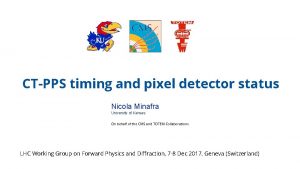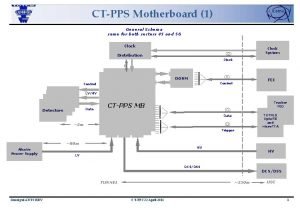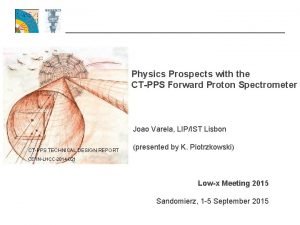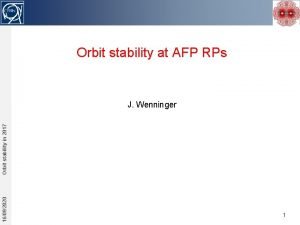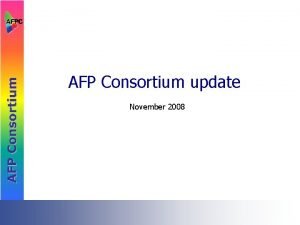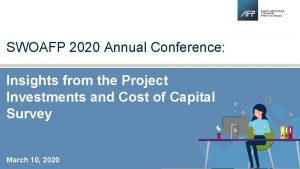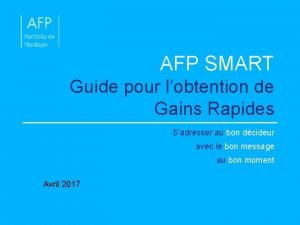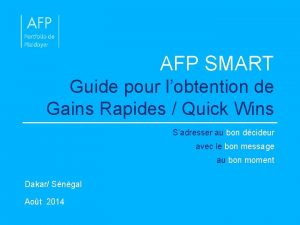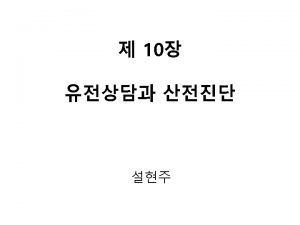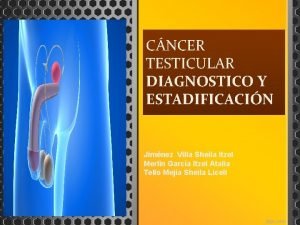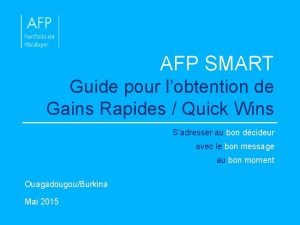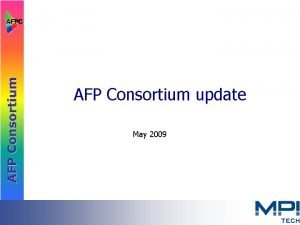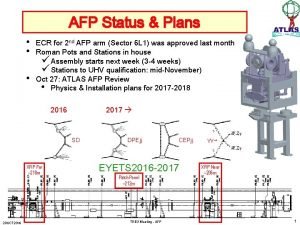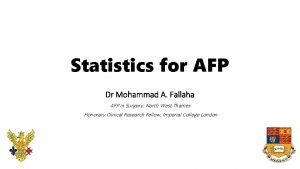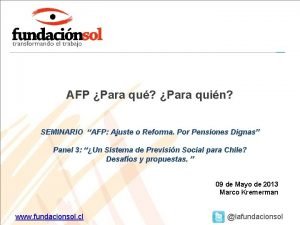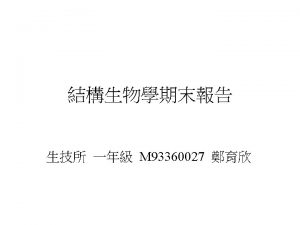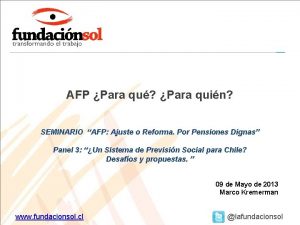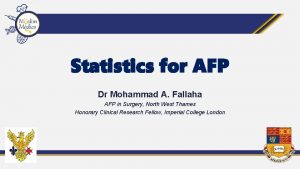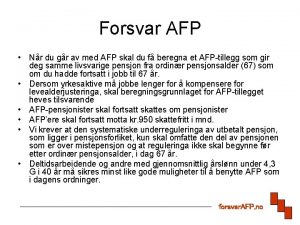CTPPS AFP experiments in the HLLHC optics landscape













- Slides: 13

CT-PPS & AFP experiments in the (HL)-LHC optics landscape S. Fartoukh (BE/ABP) • The conceptual “fragility” (optics-wise) of the CT-PPS and AFP experiments • Is there any room or un-known yet dimensions for improvement? o More or less “symbolic” actions: “Orbit bump” in 2016, “Optics bump” in 2017 o Telescopic optics based on the ATS scheme, as optics baseline for HL-LHC o Flat optics with V crossing in CMS (. . but H crossing in ATLAS) under study for Run III • Summary and outlook 28/06/2017 S. Fartoukh, update since the LHCC referee session held on 09/05/2017 1

The conceptual “fragility” of the CT-PPS & AFP experiments Both experiments rely on the small and rigid Triplet Separation dipoles D 1/2 Matching section Q 4/5/6 dispersion generated by the D 1/D 2 separation recombination dipoles. At the D 2 exit w/o crossing angle Dx 194 mm /2 97 mm & DPx 0 (angular dispersion). This dispersion is fixed by the main dipole geometry !! At the RP’s between Q 5 & Q 6: It can hardly increase by more than 2 cm, because (i) the Q 4/RP distance is short, and (ii) Q 4 (H-defocusing) has a low gradient for (standard, i. e. non-ATS) squeezed optics. L*=23 m LFFS=268 m Courtesy of R. de Maria Additional impact of an horizontal crossing angle 1. An H crossing angle can only be positive for beam 1 (otherwise leading to a “second IP” in D 1) 2. It induces a dispersion fighting against the D 1/2 dispersion by about 2. 5 cm per 100 mrad half X-angle 28/06/2017 S. Fartoukh, update since the LHCC referee session held on 09/05/2017 RP’s Dx ~ 7 cm with 185 mrad half X-angle Dx ~ 12 cm without X-angle 2

How to improve? 28/06/2017 S. Fartoukh, update since the LHCC referee session held on 09/05/2017 3

Beginnings of a CT-PPS squeeze in 2017 (animation) … Beta’s and Single-pass dispersion for beam 1 on the right side (b* is cst at the IP) Zoom in the zone of the CT-PPS RP’s (200 -220 m w. r. t. the IP) . . Not very impressive for a squeeze (only 15 -20% bx-reduction at the RPs, 200 mm dispersion increase). We should be able to do better. 28/06/2017 S. Fartoukh, update since the LHCC referee session held on 09/05/2017 4

Telescopic optics (1/3) • Recap on ATS optics (in principle) for very small b* (HL-LHC Baseline optics) 28/06/2017 S. Fartoukh, update since the LHCC referee session held on 09/05/2017 Phys. Rev. ST Accel. Beams 16, 111002 – 2013 5

• Telescopic optics (2/3) Viewed differently, the ATS can be used to preserve “standard” LHC b* (e. g. b* =40 -30 cm) in a telescopic manner: To relax the demand on the IR 1/5 matching quadrupoles themselves, Then to better optimize internal IR 1/5 constraints other than b*, e. g. much smaller bx at the pots ! Q 6> 1. 5 KA @ 1 m, offering quite some flexibility 1) For an aggressive “CT-PPS squeeze” at cst b*=1 m 2) Followed by a telescopic squeeze to reach back 40 cm IR 4 IR 5 IR 6 Q 6@300 A (quite low) at 40 cm (w/o telescope) “Natural” Q 6 current for a standard ATS pre-squeeze (w/o telescope) from 1 m to 40 cm 28/06/2017 Un-squeezing IR 5, and re-squeezing from outside to relax the demand on matching quad. ’s at cst b*=40 cm S. Fartoukh, update since the LHCC referee session held on 09/05/2017 6

Final considerations on Telescopic optics (3/3) • Even if not for b* proper, telescopic optics will need to be implemented soon in the LHC for HL-LHC optics validation, and with a large telescopic index (3 4). • At that moment CT-PPS (& AFP) will be able to profit from a much more performing “ 2017 -like CT-PPS squeeze” . . provided that roman pots equipped with new HW (as e. g. 220 F), and the machine protection are ready to go beyond the 1. 5 mm minimum gap. • Flat optics are also in the pipeline (for Run III) and are planned anyway to be done in a telescopic manner because of the aggressive (15 -20 cm) b* in one of the two planes CT-PPS will certainly “double gain” with Telescopic flat optics ( & V crossing) AFP will gain less (due to H crossing for flat optics in ATLAS). Some non-negligible R&D + MD time is still ahead to develop & validate all these idea, then precisely quantify the benefits for CT-PPS, but certainly in the 50%-100% range S. Fartoukh, update since the LHCC referee session held on 28/06/2017 09/05/2017 7

Flat optics (1/3). . CT-PPS will gain, AFP might loose ! • Round 50/50 bx, max~ 4. 4 km by, max~ 4. 4 km Effect of decreasing the beam aspect ratio at the IP (and increasing the vert. X-angle) Flat 100/25 28/06/2017 Effect of increasing the beam aspect ratio at the IP S. Fartoukh, update since the LHCC referee session held on Very old (and decreasing the vert. X-angle) 09/05/2017 bx, max~ 2. 2 km by, max~ 8. 8 km idea (CERN MAC, 2006) recently revived 8

Flat optics (2/3) • Most promising and competitive flat optics for LHC 60/15 cm with 150 mrad Half X-angle H/V in ATLAS/CMS 2. 4 E 34 peak lumi @ 6. 5 Te. V with BCMS beam (2592 collisions, 1. 2 E 11, ge=2. 5 mm, sz=7. 5 cm) and up to 3. 5 E 34 with 8 b 4 e !. . . Can be realized with a tele index of ~ (1, 4) for ATLAS and (4, 1) for CMS (still to 28/06/2017 be optimized for beam-beam) b max ~ 16 km in the separation plane ! IT multipole correction is vital ! S. Fartoukh, update since the LHCC referee session held on 09/05/2017 Aperture is at the limit @6. 5 Te. V 8. 5 s in the IT and 15 s in the MS (@Q 5 for the worst case of CMS) 9

Flat optics (3/3) • Footprint with 2 IP’s, 154 mrad half X-angle (12. 5 s @ 6. 5 Te. V and ge=2. 5 mm) With HO and LR 28/06/2017 New features showing up with LR only LR tune shift of - 0. 0035/IR Reduced cross-anharmonicity (LR spread> 0 along the diagonal) S. Fartoukh, update since the LHCC referee session held on B 6 -like spread showing up (DQ a J 2) 10 09/05/2017

With very good LR Correctability with MO (even with badly optimized telescope) MO=0 @ 154 mrad MO= -600 A @ 154 mrad 28/06/2017 MO= -200 A @ 154 mrad MO= -400 A @ 154 mrad MO= -700 A @ 154 mrad MO= -530 A @ 165 mrad S. Fartoukh, update since the LHCC referee session held on 09/05/2017 11

Other “telescopic by-products” (one example amongst others) From huge b* optics and/or faster de-squeeze using the telescopic techniques, to more luminous 90 m-like optics ! “Standard” 90 m-optics with prescribed R 12 and R 34 from the IP to the RP . . 4 times more luminous by telescopically re-squeezing to 25 m. . therefore at constant R 12 and R 34 !!. . and reopening 25 ns possibilities (at least for beam-beam effects) Still preliminary (many details to be looked at), but it might be a good idea to re-start to S. Fartoukh, update since the LHCC referee session held on 28/06/2017 brainstorm on a possible 25 ns upgrade of the electronics. . If so up to a factor ~10 in 12 lumi !! 09/05/2017

Summary & Outlook • The first step has been achieved this year by implementing the ATS in the LHC, with some immediate inconvenience for CT-PPS but also much more potential for future improvements. • The ATS is a wonderful tool for small b* but not only. A lot of imaginative work is indeed ahead to extract the best of it, in particular to serve the entire FP community. • The CT-PPS and AFP needs and limitations are now well-understood, together with clear directions for net improvement. Entering in the “telescopic era of the LHC”, both experiments can only profit from this move in the near future: not talking at the 5 -10% level, but more at the 50 -100% level ! 28/06/2017 S. Fartoukh, update since the LHCC referee session held on 09/05/2017 13


